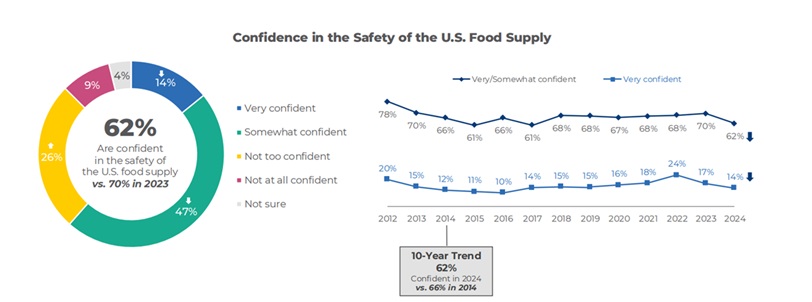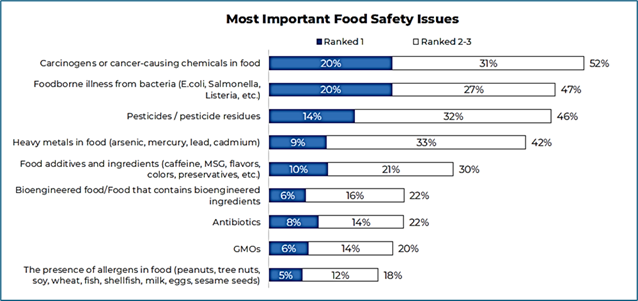The Food Safety in Modern Supply Chains session took place on February 28, 2024, at the USDA’s 101st Agricultural Outlook Forum. The session addressed where food safety fits within supply chains, who is responsible, consumers’ perceptions of food safety, and the cause and effect of changes in regulations pertaining to food traceability.
In 2024, the United States had over 300 food recalls and nearly 1,400 people became ill through contaminated food. Of the 1,400 sick people, 98% of the food causing the illness could be linked to just 13 outbreaks (Murray and Cope, 2025). During 2024, the US had numerous high-profile outbreaks including the following examples:
- Listeria monocytogenes in Boar’s Head deli meat resulting in a 19-state outbreak with 60 people sick and up to 10 deaths;
- Escherichia coli in onions served at McDonald’s resulting in a 14-state outbreak, with 34 hospitalizations and one death;
- Escherichia coli in organic carrots resulting in a 19-state outbreak, with 20 hospitalization and one death (CDC, 2025).
With steady rises in the number of food recalls and foodborne outbreaks, identifying points of contamination within a supply chain are even more crucial to maintaining consumer trust.
Consumers’ View of Food Safety and the Current Regulations – Challenging Food Safety Issues
Consumers expect their food to be safe, but there is a rising distrust in food safety with food recall rates climbing each year. Confidence in food safety has dwindled with only 62% of US consumers confident in the safety of our nation’s food compared to 70% of people in 2023 (Figure 1) (IFIC, 2024).
A food recall, whether caused by a contaminated product or not, creates bad publicity that easily reaches the eyes and ears of its targeted consumers. With approximately 97% of the US population having access to the internet, it takes a person anywhere from seconds to minutes to acquire this type of information (Petrosyan, 2024). Whether that information is accurate is another question. With increasing media coverage of food and nutrition, the spread of misinformation and malinformation has increased, as have gaps in knowledge. Misinformation is false information but is not created or shared with the intent of harm. Malinformation, on the other hand, is based on fact but is used out of context to mislead, harm, or manipulate. (Hawaii Office of Homeland Security, n.d.).
Consumer trust in a product is a crucial aspect of any brand, but the concept of “the customer is always right,” has never been harder to navigate and address. Many consumers might believe that an increase in recalls indicates that our food system is becoming less safe; however, an alternative interpretation could be that our technology has become more accurate, and that our food safety systems are more effective at identifying and/or correcting errors before they can cause harm. Collectively, the food industry needs to increase consumer access to credible information.
Figure 1: Food Information Council (IFIC) Food & Health Survey, Consumer Confidence

Source: IFIC, 2024
Aside from having confidence in a safe food supply, consumers want to understand what is in their food and its nutritional value. They want food companies to be transparent. This means the use of plain English on nutrition panels, stamps of certifications, sourcing details, and bold allergen statements. While food labeling requirements have kept up with many of these demands over the years, change takes time. The food industry struggles to satisfy the ever-changing demands of consumers in the desired timeframe.
Additionally, consumers are more aware of the potential threats found within their food including carcinogens, microbial contamination, residual pesticides, heavy metals, etc. (Figure 2) (IFIC, 2024). The food industry has found it challenging to educate consumers in a reliable, efficient, and cost-effective way without overcrowding already comprehensive food labels.
Figure 2: IFIC Food & Health Survey, Food Safety Issues

Source: IFIC, 2024
Solutions to Food Safety Challenges
This USDA Outlook session covered potential solutions to food safety and consumer communication challenges. These solutions included improved labeling, strengthened traceability requirements, and better education.
Smart Labels
Smart labeling is a proposed solution to ease the growing consumer concerns with food safety. These labels would include a QR code that transforms the average label into an interactive digital database. Smart labels provide consumers with more information about their products without the label losing its readability. However, implementation of this technology could have high upfront costs, and requires data security and standardization. The food industry will need to prepare to take on the additional workload that comes with such developments.
Food Safety Modernization Act
The pace of regulating our nation’s food system has been slow and is continuously evolving. New federal traceability regulations under the Food Safety Modernization Act (FSMA) have already added strain to the food industry with operations racing to comply. FSMA is the governmental response to the rising concerns with the safety of our nation’s food supply. With 1 in 6 people sickened by contaminated food every year, protecting public health requires our food system to change from responding to foodborne illness to preventing it (FDA, 2025).
For years, food producers have struggled to track raw ingredients throughout a supply chain to their final products in a cost-effective and efficient manner. Supply chains are becoming more complex. Federal regulations have now interceded, mandating a standardized food traceability system. Producers, manufacturers, distributors, and others must expand their record-keeping practices for “high risk” foods found on the Food Traceability List (FTL). Operations with complex supply chains are beginning to recognize gaps in their established traceability systems. These gaps include a lack of technological interoperability across different producers, limited capacity for smaller operations to effectively comply, and the ineffectiveness of a traceability plan built on purchase orders.
Producer and Consumer Education
The Outlook Forum panel identified the need for continuous education for all parties within the food system. However, the educational content needs to be relevant to each party’s role and their respective understanding of that role:
- Consumers need trustworthy, transparent, and credible information on ingredients, how their food was produced, and nutrition.
- Small producers need help navigating ever-evolving regulatory requirements and complying with changes in regulation.
- All food producers need help tracking multiple regulations such as FSMA, Good Agricultural Practices (GAP), Global Food Safety Initiative (GFSI), and other guidelines. They need easy tools to follow updates and understand if and how the new guidance impacts their operation, and how these practices align and overlap with one another. Simplifying the redundancy and gaps will go a long way toward supporting compliance.
For all roles, the panel identified the need to increase communication and provide resources that are science based with clear information. This effort must include more cohesive and efficient channels to engage and inform producers and consumers.
Attracting the Next Generation of Food Safety Professionals
As food safety requirements and consumer interest increase, so will the need for more food safety professionals. We must recruit the next generation of food scientists, farmers, and manufacturers. We will also need additional regulators, such as food safety inspectors at the federal and state levels.
Conclusion
As the food industry experiences increasing foodborne illness outbreaks and rising consumer distrust, the need for robust solutions to ensure food safety and promote consumer confidence has never been more urgent. While challenges remain, such as the complexity of modern supply chains and the spread of misinformation, there are clear paths forward. Implementing enhanced traceability systems, such as those mandated by FSMA, along with the introduction of smart labeling, will allow both producers and consumers to track food more effectively and access reliable, real-time information.
The potential of these solutions is rooted in the rapid advancements in technology, from the adoption of QR codes on labels to blockchain-driven traceability systems, which make transparency more accessible and actionable. These innovations promise not only to improve consumer confidence but also to enhance the speed and accuracy of identifying contamination points within the supply chain, ultimately reducing the incidence or scope of foodborne illness events.
Education remains a critical piece of the puzzle. Consumers must be equipped with trustworthy, science-based information that empowers them to make informed choices about their food, while producers, especially smaller operations, need support navigating the complex regulatory landscape. The food safety culture must be nurtured from farm to fork, ensuring that everyone involved in the food system understands their role in maintaining safety and is equipped with the tools and knowledge to do so.
The solutions outlined, if implemented effectively, will fundamentally strengthen the resilience of the food safety system, and consumer confidence. Through collaboration, technological innovation, and ongoing education, we can shift from a reactive to a proactive food safety culture, restoring consumer trust and ensuring that food safety remains a cornerstone of public health. With these changes in place, the food industry will be better prepared to meet both the current and future demands of a more informed, conscientious consumer base, all while ensuring that foodborne illness outbreaks become increasingly preventable.
Need Support?
SES offers a range of food safety services to help your business follow the FDA guidelines, ensuring integrity in your supply chain and maintaining transparency in marketing practices. Our services include supply chain outreach and audits, marketing consulting, and support with your HACCP, TACCP, and VACCP plans.
References
Center for Disease Control and Prevention (CDC). (2025). Multistate Foodborne Outbreak Notices. https://www.cdc.gov/foodborne-outbreaks/active-investigations/all-foodborne-outbreak-notices.html
Food and Drug Administration (FDA). (2025) Food Safety Modernization Act (FSMA). https://www.fda.gov/food/guidance-regulation-food-and-dietary-supplements/food-safety-modernization-act-fsma
International Food Information Council (IFIC). (2024) 2024 IFIC Food & Health Survey. https://foodinsight.org/wp-content/uploads/2024/06/2024-IFIC-Food-Health-Survey.pdf
Murry, T. and Cope, S. (2025, February). Food for Thought 2025. U.S. PIRG Education Fund. https://publicinterestnetwork.org/wp-content/uploads/2025/02/FOOD-FOR-THOUGHT-2025-2-12-FINAL-1.pdf
Petrosyan, A. (2024, March 13). Internet usage in the United States- Statistics & Facts. https://www.statista.com/topics/2237/internet-usage-in-the-united-states/#topicOverview
Hawaii Office of Homeland Security. (n.d.). OHS misinformation center. https://law.hawaii.gov/ohs/ohs-misinformation-center/

